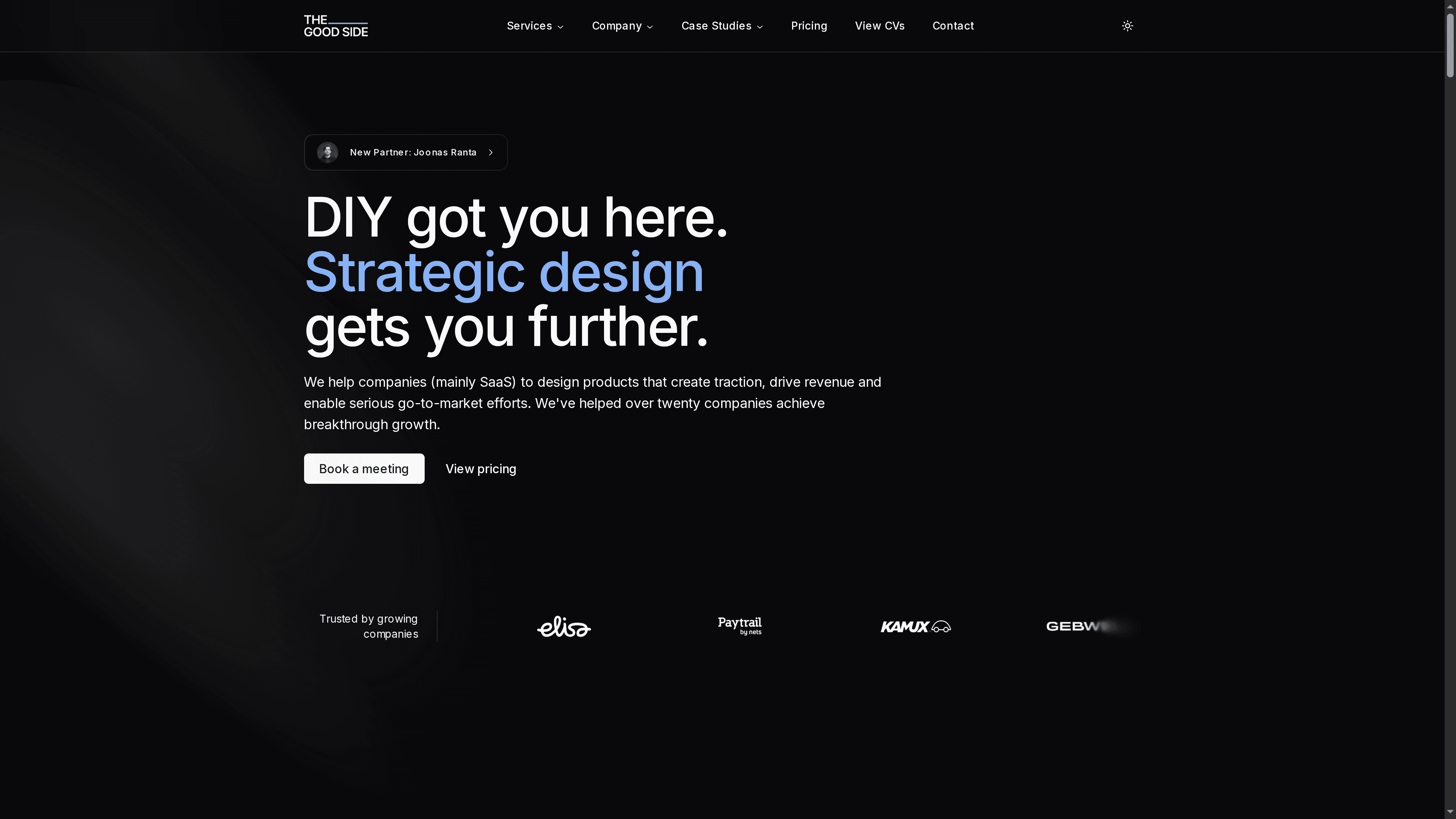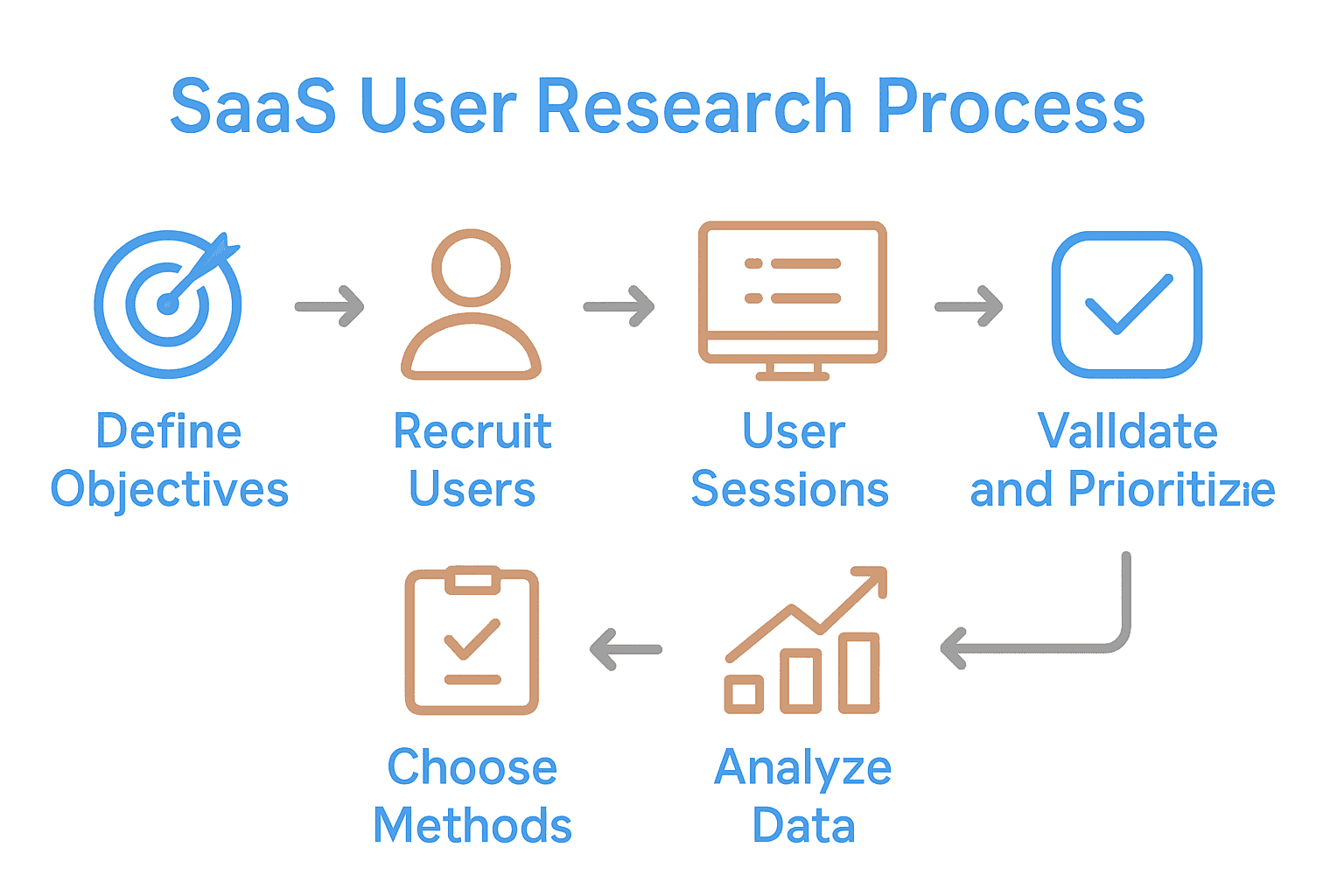Master the User Research Process for SaaS Success
Learn the step-by-step user research process tailored for SaaS. Discover how to gather insights, analyze findings, and drive better product decisions.

Most american product teams overlook how powerful structured user research can be. Only about 55 percent of digital projects actually use clear research objectives before making design changes. For anyone looking to build software that truly fits user needs, understanding each research step matters. This guide highlights practical ways american teams can collect, analyze, and act on user insights so they turn data into real improvements that users will notice.
Table of Contents
- Step 1: Define Research Objectives And Scope
- Step 2: Identify And Recruit Target Users
- Step 3: Design Effective Research Methods
- Step 4: Conduct Insightful User Sessions
- Step 5: Analyze Data And Extract Actionable Insights
- Step 6: Validate Findings And Prioritize Actions
Quick Overview
| Main Insight | Detailed Explanation |
|---|---|
| 1. Define Specific Research Objectives | Clearly articulate research goals to guide the methodology and help collect meaningful user data. |
| 2. Recruit Target Users Thoughtfully | Create detailed user personas and use diverse recruitment channels to ensure accurate representation in research. |
| 3. Choose Effective Research Methods | Use a mix of qualitative and quantitative methods, ensuring scenarios are natural to capture genuine user experiences. |
| 4. Analyze Data Systematically | Organize data into categories and themes to identify user pain points and opportunities for product enhancement. |
| 5. Validate Insights and Prioritize Actions | Test findings with follow-up sessions and create a prioritization framework to ensure proposed solutions meet user needs. |
Step 1: Define research objectives and scope
Determining clear research objectives is your foundational step in transforming user insights into actionable design strategies. As Userlytics emphasizes, these objectives will guide your entire research methodology and ensure you collect meaningful data that directly informs design decisions.
Start by asking yourself critical questions about what you genuinely want to understand about your users. Are you investigating user pain points in your current product experience? Exploring new feature potential? Understanding user behaviors and preferences? According to Innerview, research objectives should be specific, measurable, and aligned with your project’s core aims.
To craft effective research objectives, break down your goals into precise, answerable questions. For instance, instead of a vague goal like “understand user satisfaction,” create a targeted objective such as “identify the top three user friction points in our onboarding workflow.” This specificity transforms broad intentions into concrete research targets. Avoid the temptation to create overly complex objectives that dilute your focus.
Pro tip: Always connect your research objectives directly to potential design or product improvements. Your objectives are not academic exercises but practical tools for creating better user experiences.
Once you’ve defined your objectives, you’re ready to map out the specific research methods and scope that will help you gather the insights you need.
Step 2: Identify and recruit target users
Recruiting the right participants is crucial for gathering meaningful user research insights that will drive your product design forward. GitLab’s handbook highlights the importance of carefully identifying and selecting your target audience to ensure research accuracy.
Begin by creating a detailed user persona that goes beyond basic demographics. Think about specific characteristics like professional role, technology comfort level, frequency of product usage, and unique challenges your potential users face. According to dsf, defining precise participant criteria helps you build a representative research sample that provides genuine insights.
Consider multiple recruitment channels to diversify your participant pool. Professional networks, user communities, social media platforms, and targeted email campaigns can all be effective. Create a compelling recruitment screener that filters candidates based on your research objectives while making participation feel valuable and interesting.
Pro tip: Offer meaningful incentives that reflect the time and effort participants will invest. These could range from direct compensation to exclusive product access or early feature previews.
With your target users identified and recruitment strategy mapped out, you are now prepared to move forward with scheduling and conducting your research sessions.

Step 3: Design effective research methods
Choosing the right research methods is critical to uncovering meaningful user insights that will transform your product design. Wikipedia’s user research overview highlights the importance of selecting methodologies that directly align with your research objectives and user understanding.
Your research toolkit should include a mix of qualitative and quantitative methods. According to Wikipedia’s user-centered design framework, the key is to prioritize methods that reveal user characteristics, behaviors, and specific task interactions. Consider combining techniques like in-depth interviews, usability testing, surveys, contextual inquiries, and user journey mapping to create a comprehensive research approach.
When designing your research methods, focus on creating scenarios that feel natural and unbiased. Develop open ended questions that encourage participants to share genuine experiences and insights. Avoid leading questions that might inadvertently steer responses. Structure your research protocols to capture both explicit feedback and subtle user behaviors that might reveal deeper product interaction patterns.
Pro tip: Always pilot test your research methods with a small group first. This allows you to refine your approach, identify potential biases, and ensure your research instruments will generate actionable insights.
With your research methods carefully designed, you are now ready to move into the execution phase of your user research project.
Step 4: Conduct insightful user sessions
Conducting effective user sessions is your opportunity to transform theoretical research objectives into real world insights. Wikipedia’s user experience overview emphasizes the critical importance of understanding user perceptions during direct interactions.
Create a comfortable environment that encourages open and honest feedback. According to Wikipedia’s user-centered design approach, successful sessions rely on iterative testing that prioritizes user needs and experiences. Begin by establishing rapport with participants through a brief introduction and explanation of the session goals. Use a conversational tone that helps participants feel at ease and willing to share genuine insights.
Structure your user sessions with a mix of guided tasks and open ended exploration. Prepare a flexible protocol that allows you to dive deeper into unexpected insights while maintaining a clear research focus. Use think aloud protocols where participants verbalize their thoughts and feelings as they interact with your product. Observe not just what users do but how they feel during the process. Pay attention to nonverbal cues body language and emotional reactions that might reveal deeper user experience challenges.
Pro tip: Record your sessions with participant consent. Video recordings allow you and your team to revisit subtle nuances and interactions that might be missed during live observation.
Learn more in our guide on UX research advantages for SaaS companies to understand how these insights can transform your product strategy. With your user sessions complete you are now ready to analyze and synthesize the rich data you have gathered.
Step 5: Analyze data and extract actionable insights
Turning raw user research data into meaningful product improvements requires a strategic and systematic approach. Wikipedia’s user research overview underscores the importance of transforming collected information into concrete design recommendations.
Begin by organizing your data into clear categories and themes. According to Wikipedia’s user-centered design principles, the goal is to identify consistent patterns and pain points that reveal genuine opportunities for product enhancement. Use techniques like affinity mapping to group similar observations and insights. Look for recurring challenges users encounter and moments of friction in their product experience. Pay special attention to emotional responses and qualitative feedback that numerical data might not capture.
Develop a structured framework for prioritizing insights based on their potential impact. Create a matrix that evaluates each insight against criteria like frequency of occurrence, severity of user frustration, and estimated implementation complexity. This approach helps you focus on changes that will deliver the most significant improvements to user experience. Collaborate with your design and product teams to translate these insights into specific design recommendations and potential feature iterations.
Pro tip: Always validate your interpretations. Return to your raw data multiple times and have team members independently review the analysis to ensure objectivity and reduce potential bias.
Learn more about UX research advantages to understand how these insights can drive meaningful product transformation. Your data analysis sets the stage for strategic product improvements that directly address user needs.
Step 6: Validate findings and prioritize actions
Validating research findings is the critical bridge between insights and meaningful product improvements. Wikipedia’s user-centered design principles emphasize the importance of iterative testing to ensure that your proposed actions truly address user needs.
Conduct validation through targeted follow-up sessions that test your initial interpretations and proposed solutions. According to Wikipedia’s user experience framework, this process involves assessing user perceptions and responses to potential changes. Create lightweight prototypes or mockups that represent your key insights and present them to a subset of your original research participants. Ask them to interact with these concepts and provide feedback that confirms or challenges your initial analysis.
Develop a rigorous prioritization framework that balances user impact with business constraints. Evaluate each potential action across multiple dimensions including user value, implementation complexity, development effort, and strategic alignment. Use a scoring system that assigns weighted values to these factors allowing you to objectively rank potential improvements. This approach transforms subjective insights into a clear roadmap of actionable enhancements that can drive meaningful product evolution.
Pro tip: Build consensus across teams by sharing validation results transparently. Create visual representations of your findings that make the rationale behind prioritized actions clear and compelling.
Learn more about UX research advantages for understanding how systematic validation transforms user insights into strategic product development. Your validated findings now provide a solid foundation for targeted product improvements.
Elevate Your SaaS Product with Strategic User Research Support
User research is the key to understanding user behaviors, pinpointing friction points, and transforming feedback into actionable design improvements as outlined in “Master the User Research Process for SaaS Success.” If you struggle with defining clear research objectives or turning insights into meaningful product enhancements you are not alone. Many SaaS teams face challenges like disconnected user journeys and unclear positioning that hold back activation and conversions.
The Good Side Oy bridges these gaps by offering seasoned SaaS-specialized designers who excel at crafting cohesive user experiences informed by rigorous research. From strategic positioning to end-to-end user journey optimization our flexible engagements help you start quickly and scale confidently without the overhead of traditional hiring. Discover how our tailored approach can help you unlock growth with improved product insights and design decisions.

Harness the power of expert user research and design strategy today. Visit The Good Side to book your free design audit, explore our UI/UX design and user research services, and see how our team can partner with you to turn insights into revenue-boosting product improvements. Don’t wait to create seamless user journeys and elevate your SaaS success.
Frequently Asked Questions
How do I define clear research objectives for user research?
Establishing clear research objectives is essential for effective user research. Start by asking specific questions about what you want to learn from your users, such as identifying pain points or understanding user behaviors. This clarity will guide your research methodology and help you gather meaningful insights.

What methods should I use for user research in a SaaS environment?
To uncover valuable user insights, combine qualitative methods like interviews and usability testing with quantitative approaches such as surveys. This mixed-methods strategy helps you gather a comprehensive view of user experiences, making your research more effective. Focus on the goals of your research when selecting appropriate methods.
How can I effectively recruit target users for my research?
Recruiting the right participants is crucial for gathering authentic insights. Develop detailed user personas and use various recruitment channels like social media and professional networks to find individuals who fit your criteria, ensuring a diverse and representative sample for your research sessions.
What strategies can I use to analyze data from user research?
Begin by organizing your data into clear categories to identify patterns and pain points. Utilize techniques like affinity mapping to group similar observations and guide your prioritization of insights based on their potential impact on product improvements.
How do I validate my findings after user research sessions?
Validation of findings is essential for ensuring your proposed product changes effectively address user needs. Conduct follow-up sessions with participants to test prototypes or mockups based on your insights, gathering feedback to confirm or refine your initial analysis. Aim to achieve consensus across teams by transparently sharing the results of these validations.
What should I do with the insights from my user research?
Transform insights into actionable improvements by collaborating with your design team to develop targeted design recommendations. Prioritize changes based on user value and implementation complexity, and create a clear roadmap for enhancements that align with your strategic goals.